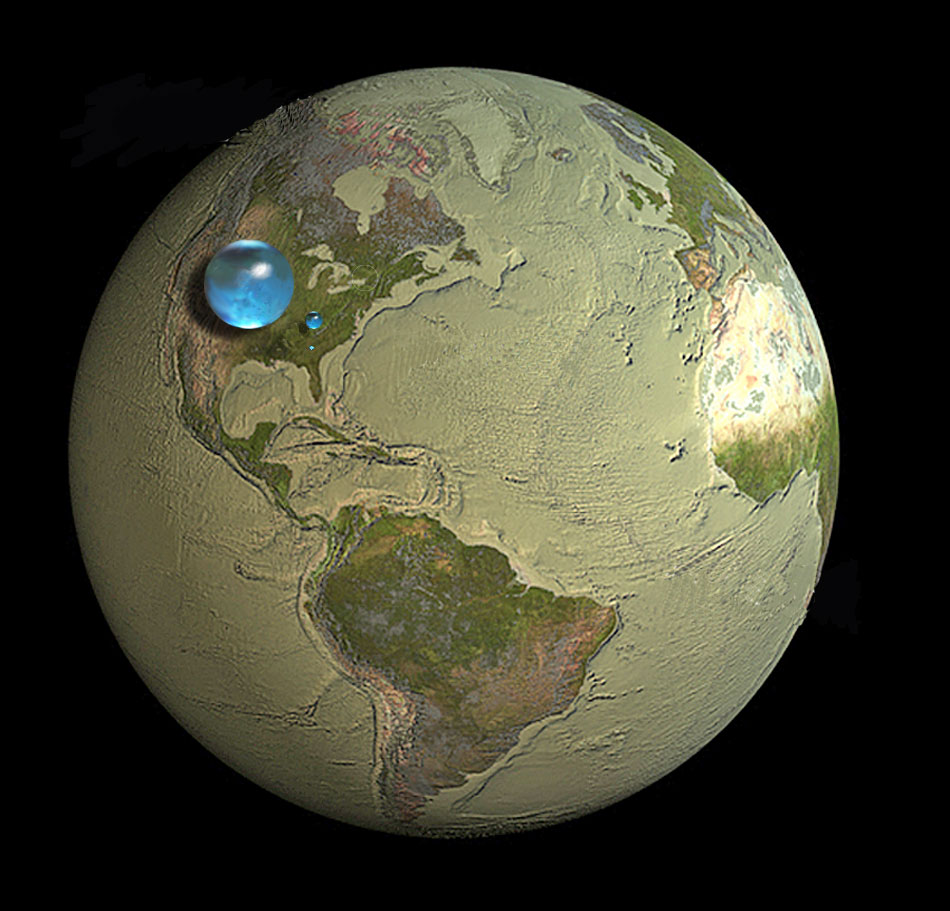Here is an image posted by one of my students to the last discussion forum of this semester in my Sustainability Studies 220 Water course, along with her comment about it.
It can sometimes be challenging to wrap our minds around water scarcity on Earth when we so often picture it as a blue planet with immensely deep seas. Graphs certainly help to put the idea of water scarcity in perspective, but nothing has driven home this idea as much for me as this image from the USGS. The large blue bubble represents the volume of all the water (salt and fresh) on Earth (its diameter being 860 miles) in comparison to the volume of Earth. The small bubble represents the freshwater on Earth (including the water that is within trees, plants, you and I). And the teeny tiny blue dot by Georgia (look closely) represents all the freshwater that is accessible for our use. It looks smaller than the Great Lakes, but you must imagine it in three dimensions.
We live in a very visual culture. What water-related environmental images have you come across that have had a strong impact on you? What campaigns can you think of that have been successful in using images to impact change? How do you see art, photography, film, etc, having a role in expanding awareness on these critical issues we face? ~Jessie
One of the great things about the USGS page this comes from is that this arresting visual representation of the volume of Earth’s water (and fresh water, and available fresh water) compared to the total volume of Earth as a whole is then accompanied by statistical data and explanations that help us understand the physical story being told in that image. This in turn highlights, and then complicates, the often-evoked dichotomy of image (emotion) and text (reason) — the assumption in popular culture that pictures speak to our hearts and guts, while words appeal to our minds.
Of course, we know that dichotomy to be simplistic, if not simply false. Images such as this do more than pull at our heartstrings — consider the lonely and threatened polar bear here, or seals with fur matted with oil; they get us to think; they cause us to ask questions — in this case, about scale, about the relationship of water to the rest of the Earth’s mass, about the thinness and fragility of the biosphere (which is defined by water, without which there would be no “bio”).
Conversely, textual discourse — whether a poem or a scientific technical report — can stoke our emotions and even spur us to action, especially if we’re open to receiving its message and understand its internal logic. The impacts and effects of both text and image are wonderfully complex, and in the best cases work together more powerfully than they can separately. This example of Earth’s water is a fine case of that, writ large.
The work of science is phenomenally important to the advancement of sustainability in human communities — both in terms of economics and social equity — as well as to the conservation of natural ecosystems, basic resources (air, water, soil), and species. But science alone cannot change the policy that governs our human actions and regulates our excessive tendencies to waste, to think only of the short term, to ignore the unintended consequences of our technologies.
For those huge and ever-present challenges, we also need ideas — and those are debated and created in the creative fires of the arts and humanities in ways that cannot be replicated in scientific and political discourse. For sustainability to be a guiding force of human culture as well as a central feature of our governments (regardless of political persuasion), it needs art, music, literature, and other creative endeavors that define us as a species. And it needs people to connect such expressions to the worlds of science and policy as much as possible, as a means of building bridges and reshaping our views of the world — and our role in it.
